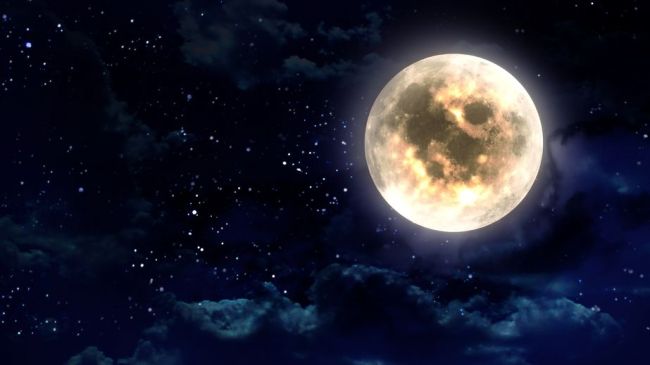
The moon is covered with soil containing a water substructure created by the constant stream of charged particles coming from the sun, U.S. researchers say.
The substructure, known as a hydroxyl, consists of one atom of hydrogen and one of oxygen, or OH, rather than two of hydrogen and one of oxygen, or H2O, the researchers from the University of Tennessee at Knoxville, University of Michigan and California Institute of Technology reported in the journal Nature Geoscience.
Scientists have known for about five years that the traditional view that the moon was bone dry was incorrect.
Spacecraft observations and new lab measurements of Apollo lunar samples found icy drops of water on the lunar surface.
NASA's robotic Lunar Crater Observation and Sensing Satellite crashed into a permanently shadowed southern lunar crater at 6,200 mph in 2009. The crash -- equivalent to detonating 2 tons of TNT -- sent a plume of material into the sky that scientists discovered was rich in water ice.
But they weren't sure how the water got there. It could have been indigenous or been a result of other sources, such as collisions from water-bearing comets.
The researchers concluded in the Nature Geoscience study that positively charged subatomic hydrogen proton particles coming from the solar wind -- a stream of charged particles ejected from the sun's upper atmosphere -- appear to have combined with oxygen on the moon's surface to form the OH hydroxyls.
The result is an "unanticipated, abundant reservoir" of OH and water in the dust, soil, broken rock and other loose material on the lunar surface, the authors wrote in the study, published online Sunday.
"Our work shows that the 'water' component, the hydroxyl, is widespread in lunar materials, although not in the form of ice or liquid water that can easily be used in a future manned lunar base," Michigan geological sciences Professor Youxue Zhang said.
"This also means that water likely exists on Mercury and on asteroids such as Vesta or Eros further within our solar system," lead author Yang Liu from Tennessee said. "These planetary bodies have very different environments, but all have the potential to produce water."
Vesta is the second most-massive asteroid in the solar system's asteroid belt between the orbits of Mars and Jupiter. Eros is a near-Earth, Mars-crosser asteroid that the NEAR Shoemaker probe observed in a 1998 flyby and in 2000 photographs before landing on it in 2001.
Earth would receive the solar wind too, but its atmosphere and magnetic field deflect it. The moon has no such protection. (UPI)
<관련 한글 기사>
달 표면은 촉촉하다?
미국 과학자들이 달 표면은 태양광선으로 인해 만들어진 물의 하위구조를 함유한 토양으로 뒤덮였다고 주장했다.
수산기 (hydroxyl: 히드록시기)라고 알려진 이 물질은 수소원자 하나와 산호원자 하나로 구성되어 있어, 수소원자 두 개와 산소원자 하나로 이뤄진 물과 구성요소가 비슷하다.
수산기가 달 표면에 존재한다는 사실은 이미 탐사선에 의해 지난 2009년에 밝혀졌으나 이 물질들이 어떻게 달 표면에 존재하게 되었는지는 알려지지 않았다.
그러나 테네시 대학과 미시건 대학, 캘리포니아 공과대학 과학자들이 공동으로 진행한 연구에 따르면 달로 날아온 태양풍 속의 양성을 띈 수소 아원자 입자가 달 표면의 산소 입자와 합쳐져 수산기가 만들어졌다고 한다.
이렇게 해서 먼지와 토양, 바위 속에 “유례가 없을 정도로 풍부한” 수산기 입자가 함유되는 결과를 낳게 되었다.
“우리 연구에 따르면 “물”입자인 수산기는 달에서 나온 물질들에 널리 퍼져있다는 것을 알 수 있습니다. 비록 쉽게 이용할 수 있는 얼음이나 물 형태로 되어 있지는 않지만 말입니다’라고 미시건의 지질학 교수 유슈 장이 밝혔다.
“이는 (연구결과는) 수성, 혹은 베스타, 에로스 같은 소행성에도 물이 존재할 수 있다는 점을 시사합니다. 이러한 천체들은 각자 환경들이 매우 다르지만, 모두 물을 생성할 수 있는 가능성을 갖고 있습니다”라고 연구를 주도한 테네시 대학의 양 류는 말했다.
이 연구는 과학 저널 네이쳐 지오사이언스 온라인 판에 14일 (현지시간) 게재되었다.





![[Graphic News] Number of coffee franchises in S. Korea rises 13%](http://res.heraldm.com/phpwas/restmb_idxmake.php?idx=644&simg=/content/image/2024/05/02/20240502050817_0.gif&u=)



![[Robert J. Fouser] AI changes rationale for learning languages](http://res.heraldm.com/phpwas/restmb_idxmake.php?idx=644&simg=/content/image/2024/05/02/20240502050811_0.jpg&u=)







![[Eye Interview] 'If you live to 100, you might as well be happy,' says 88-year-old bestselling essayist](http://res.heraldm.com/phpwas/restmb_idxmake.php?idx=652&simg=/content/image/2024/05/03/20240503050674_0.jpg&u=)
